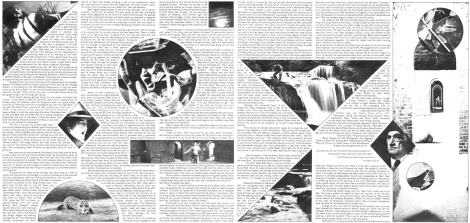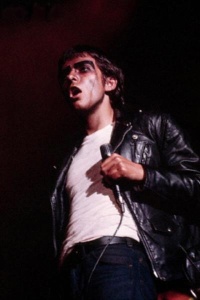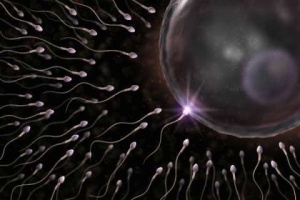In this post, I make a brave decision to spotlight Genesis’ heavily cryptic 1975 single that Peter Gabriel sang as a leather-clad, half-Puerto Rican delinquent named Rael, revealing how it still has the power to encapsulate the desperate search for salvation that is inherent in all of us (probably).
The carpet crawlers heed their callers.
“We’ve got to get in to get out.”
Seeing the white-bearded Peter Gabriel reunite with his old band mates for the Genesis documentary Sum of the Parts recently, I was pleased to be reminded that before the singer became the genial elder statesman of rock, human-rights activist and world-music champion that we know and love, he was the theatrical frontman and flautist (and occasional oboist) of an experimental prog-rock outfit, who was prone to appear onstage ‘in character’ as a chap called Rael, or sometimes as a fox or a bat. Or a flower. I was particularly struck anew by one of his sublime musical creations from this former era, ‘The Carpet Crawlers’, a track that originally featured on side 2 (track 4) of the double concept album The Lamb Lies Down on Broadway (1974), before making history as the very last Genesis single to feature his distinctive tones ![cover_1634142562008[1]](https://adsvinyladventures.files.wordpress.com/2015/01/cover_16341425620081.jpg?w=470) (prior to 1999, that is). So with it also being 40 years in April since it was first released on seven-inch vinyl, I deemed it a good time to discover, once and for all, its true meaning, which may well have something to do with the notion of transcending the sinful predicament of earthly existence, depending on what significance we attach to the ‘red ochre corridor’ and the ‘mild-mannered supermen’, not forgetting, of course, the ‘porcelain mannequin with shattered skin‘.
(prior to 1999, that is). So with it also being 40 years in April since it was first released on seven-inch vinyl, I deemed it a good time to discover, once and for all, its true meaning, which may well have something to do with the notion of transcending the sinful predicament of earthly existence, depending on what significance we attach to the ‘red ochre corridor’ and the ‘mild-mannered supermen’, not forgetting, of course, the ‘porcelain mannequin with shattered skin‘.
I am aware that in my obsession to unravel the mystery of ‘The Carpet Crawlers’, brought on (I think) by the spiritual desolation of a particularly grim February, I expose myself to all manner of prejudice and abuse from progressive-rock detractors who say the genre is boring and pretentious – and there are a lot of them. These people fail to appreciate that prog rock is actually quite cool at the moment (in certain circles), due partly to the resurgence of US metal band Periphery, who quite brazenly deal in unconventional and lengthy song structures, instrumental virtuosity and polyrhythmic patterns, while finding no shame at all in releasing epic concept albums. These people are also blind to the fact that The Lamb is highly regarded by critics despite its reputation as overblown, with esteemed rock journalist Nick Kent having hit the nail on the head when he deemed it a work with a ‘compelling appeal that often transcends the hoary weightiness of the mammoth concept that holds the equally mammoth four sides of vinyl together’. And anyway, ‘The Carpet Crawlers’ itself, sometimes known as ‘Carpet Crawler’ or ‘Carpet Crawl’, is not all that proggy at all in terms of its structure, being a fairly traditional verse-chorus-verse composition, devoid of any exploratory instrumental breaks, spoken-word sections or tempo changes, which, for all that, is a mere five minutes long! It is furthermore an absolute pinnacle of 70s rock that many consider to be the band’s finest song and which Gabriel rates as one of his most accomplished pieces, despite its failure to make any impact whatsoever on the UK top 40. It is also a tune that became a live favourite long after its chief creator left the group, when ![The_Carpet_Crawlers_1999[2]](https://adsvinyladventures.files.wordpress.com/2015/01/the_carpet_crawlers_19992.jpg?w=470) the rather less enigmatic Phil Collins took over lead-vocal duties. It was subsequently re-recorded with long-lost Peter in 1999 as the aptly titled ‘The Carpet Crawlers 1999’, before seeing inclusion on the current, craply-titled R-Kive compilation, so as to beguile a whole new generation of fans.
the rather less enigmatic Phil Collins took over lead-vocal duties. It was subsequently re-recorded with long-lost Peter in 1999 as the aptly titled ‘The Carpet Crawlers 1999’, before seeing inclusion on the current, craply-titled R-Kive compilation, so as to beguile a whole new generation of fans.
The essence of the original ‘Crawlers’ is an amazing vocal by a massively underrated singer, because while the song inches along eerily and indeed has a crawling sound to it that is accentuated by slithery keyboard effects and percussion, it is Gabriel’s performance at the mike that provides the real drama. For certainly it is his grave vocal, steadily building in intensity and desperation, that lends the lyrics so much mystical and spiritual import, demanding that they be understood. And here is the challenge, because the words are what you might call proggy, being epic, mysterious and replete with symbolism and bafflingly surreal imagery, resulting in blogs and chat rooms that abound with fans trying desperately to interpret them. These interpretations vary greatly, which is little wonder when seemingly nothing is literal and everything is a metaphor, sometimes even a double metaphor or, heaven help us, a parallel metaphor.
Even with its figurative density, it is reasonable to assume that because ‘Crawlers’ was released as a single, it makes some kind of sense on its own terms, yet there can be no doubt that to heighten our understanding we must analyse it within the grand narrative of the massively complex and often-incoherent Lamb album. This is a daunting prospect for any man, especially when it not only involves having to decipher abstract lyrics, but also the album’s reams of confusing liner notes and dreamlike images, for which a magnifying glass is heartily recommended!
 Yet we must at least try to respect Gabriel’s overall vision for the record, who seems to have been much taken by the idea of a hero undertaking an episodic spiritual journey in the style of John Bunyan’s Pilgrim’s Progress of 1678, a Christian text in which (wouldn’t you know it?) nothing is literal and everything is a metaphor. The hero is
Yet we must at least try to respect Gabriel’s overall vision for the record, who seems to have been much taken by the idea of a hero undertaking an episodic spiritual journey in the style of John Bunyan’s Pilgrim’s Progress of 1678, a Christian text in which (wouldn’t you know it?) nothing is literal and everything is a metaphor. The hero is  Rael, a New York immigrant who, usually in the first person, relates his experiences as a tough kid on the neon-lit streets of Manhattan, where he indulges a love of graffiti, vandalism and criminal violence. He drops a hint in the opening title track that he has lately committed a horrific gun crime, which has led to a kind of awakening: ‘something inside me has just begun’ (spiritual, see?). He subsequently seems to progress into the realm of fantasy when he describes a great cloud of dust enveloping New York (‘Fly on the Windshield’), while providing some satirical commentary on consumerism (‘Cuckoo Cocoon’), and then blacking out and getting trapped in a cage, from where he sees his brother John disappear inexplicably (‘In the Cage’). He then alludes to a period of drug addiction in the menacing rocker ‘Back in NYC’, when he says: ‘Who needs illusion of love and affection / When you’re walking the streets with your mainline connection’. This is prior to entering a period of revelation and possible repentance in ‘Crawlers’, where the biblical symbolism is really stepped up a notch, with added Greek mythology thrown into the mix.
Rael, a New York immigrant who, usually in the first person, relates his experiences as a tough kid on the neon-lit streets of Manhattan, where he indulges a love of graffiti, vandalism and criminal violence. He drops a hint in the opening title track that he has lately committed a horrific gun crime, which has led to a kind of awakening: ‘something inside me has just begun’ (spiritual, see?). He subsequently seems to progress into the realm of fantasy when he describes a great cloud of dust enveloping New York (‘Fly on the Windshield’), while providing some satirical commentary on consumerism (‘Cuckoo Cocoon’), and then blacking out and getting trapped in a cage, from where he sees his brother John disappear inexplicably (‘In the Cage’). He then alludes to a period of drug addiction in the menacing rocker ‘Back in NYC’, when he says: ‘Who needs illusion of love and affection / When you’re walking the streets with your mainline connection’. This is prior to entering a period of revelation and possible repentance in ‘Crawlers’, where the biblical symbolism is really stepped up a notch, with added Greek mythology thrown into the mix.
Having some idea of the narrative thread of the album, we can proceed to address the internal storyline of ‘Crawlers’, and really, what could be simpler?! To put it in a nutshell: Rael finds himself with lamb’s wool under his naked feet, noticing that there are fleas clinging to the Golden Fleece, all of whom hope ‘they’ll find peace’. He sees that ‘crawlers cover the floor in the red ochre corridor’ and that they are all ‘moving in time to a heavy wooden door’, where ‘the needle’s eye is winking, closing in on the poor’. This is corroborated in the notes, where it states that ‘he can see some people; all kneeling’, who struggle ‘towards a wooden door at the end’. He finds that the crawlers are all heeding their callers and crying “we’ve got to get in to get out”, while intent on getting ‘upward to the ceiling, where the chamber’s said to be’ and where ‘a harvest feast is lit by candlelight’, behind which is ‘a spiral staircase that leads upwards out of sight’. However, there are strange goings-on in the chamber, for sure, notably that ‘the porcelain mannequin fears attack’, the ‘liquid has congealed’ and ‘the tickler takes his stickleback’.
To comprehend what any of the lyrics actually mean, it might be helpful, in the first instance, to decide what the red ochre corridor stands for. I place myself firmly in the purgatory camp on this one, because several images converge to suggest that Rael is in a place where souls experience temporary suffering in a bid to purify themselves of mortal sin and be reborn in the kingdom of heaven. The crawlers could be monks kneeling in prayer, and the idea of them clinging to the Golden Fleece suggests that they are clinging to a symbol of god-like authority (how am I doing so far?). That they have to get in to get out means that they have to pass through purgatory in order to exit into the afterlife, or heaven. Why else would we have the allusion to the famous parable stating that it is easier for a camel to pass through the eye of a needle than for a rich man to pass into the kingdom of heaven? The monks’ callers are more than likely their heavenly judges who will decide their ultimate destiny, and that I am on the right track here is confirmed to me by a devout fellow on the ever-entertaining SongMeaning website, who is remarkably self-assured in his view that Peter Gabriel’s words define him as some kind of mystical conduit: ‘Guys, I believe the lyrics were inspired by Spirit… I tell you with love, it was written through Gabriel… I do not mean to be confrontational but I want to pull back a curtain for you so you may see what lies beyond this earthly existence’. In the process of enlightening us, he proceeds to state, maybe ever-so-slightly patronisingly, that the corridor is a place we all go to after we leave this world: ‘This may be a concept that you find difficult to understand but actually not really, for our essence is spirit is it not?’
they have to get in to get out means that they have to pass through purgatory in order to exit into the afterlife, or heaven. Why else would we have the allusion to the famous parable stating that it is easier for a camel to pass through the eye of a needle than for a rich man to pass into the kingdom of heaven? The monks’ callers are more than likely their heavenly judges who will decide their ultimate destiny, and that I am on the right track here is confirmed to me by a devout fellow on the ever-entertaining SongMeaning website, who is remarkably self-assured in his view that Peter Gabriel’s words define him as some kind of mystical conduit: ‘Guys, I believe the lyrics were inspired by Spirit… I tell you with love, it was written through Gabriel… I do not mean to be confrontational but I want to pull back a curtain for you so you may see what lies beyond this earthly existence’. In the process of enlightening us, he proceeds to state, maybe ever-so-slightly patronisingly, that the corridor is a place we all go to after we leave this world: ‘This may be a concept that you find difficult to understand but actually not really, for our essence is spirit is it not?’
If we are to accept that Rael is depicting a vision of purgatory in ‘Crawlers’, it would not be too much of a stretch to suggest that the porcelain mannequin represents Jesus Christ himself (would it?). But the song might also be portraying Rael’s revelatory experience as a vision into the circle of life as a rather more biological affair. Many  indeed suggest that the carpet crawlers are sperms, who must – to get in to get out – penetrate the egg in order to become human, or that they are in fact babies or toddlers. Personally, though, I find it hard to imagine that the visionary Gabriel sat down to write a song about sperms or toddlers, especially after reading one chat-room visitor’s all-too-graphic explanation of the liquid congealing and seeping out through the crack: ‘the crack could be referring to the vagina and the liquid seeping out could be semen’, because ‘at the onset of labour, there is a jelly-like discharge from the vagina’. On a whole other level, however, I do feel able to get on board with the idea that Rael could be describing a crack-cocaine trip, for the simple reason that ‘carpet crawlers’ is a slang expression for crack addicts who scavenge around on the floor for remaining stones (or ‘rocks’) after a fix – and as we know, Rael possibly alluded to drug addiction earlier on in the album. But, hang on, crack in this freebase form was unknown in England (and New York) in 1974, first seeing widespread use in late 1984 and ’85. So forget that.
indeed suggest that the carpet crawlers are sperms, who must – to get in to get out – penetrate the egg in order to become human, or that they are in fact babies or toddlers. Personally, though, I find it hard to imagine that the visionary Gabriel sat down to write a song about sperms or toddlers, especially after reading one chat-room visitor’s all-too-graphic explanation of the liquid congealing and seeping out through the crack: ‘the crack could be referring to the vagina and the liquid seeping out could be semen’, because ‘at the onset of labour, there is a jelly-like discharge from the vagina’. On a whole other level, however, I do feel able to get on board with the idea that Rael could be describing a crack-cocaine trip, for the simple reason that ‘carpet crawlers’ is a slang expression for crack addicts who scavenge around on the floor for remaining stones (or ‘rocks’) after a fix – and as we know, Rael possibly alluded to drug addiction earlier on in the album. But, hang on, crack in this freebase form was unknown in England (and New York) in 1974, first seeing widespread use in late 1984 and ’85. So forget that.
 small fish, like a minnow, and tickling being a way of fishing’ (gee, thanks for that!). Another maintains that it is utterly futile to even attempt to apply one definitive explanation to the track, due to the simple fact that you would be wrong: ‘I think it is a mistake to think it is “about” something… I would advise you to be wary of people who claim to have an answer to the question, because they are probably missing a lot’.
small fish, like a minnow, and tickling being a way of fishing’ (gee, thanks for that!). Another maintains that it is utterly futile to even attempt to apply one definitive explanation to the track, due to the simple fact that you would be wrong: ‘I think it is a mistake to think it is “about” something… I would advise you to be wary of people who claim to have an answer to the question, because they are probably missing a lot’.
 such as when ‘the eager pack lift up their pitchers’ mysteriously becomes ‘the eagle pack lift up their pitchers’, which is the way I perceived it for a very long time (quite happily, if I’m honest). Furthermore, with Gabriel not being in any way inclined (or able?) to explain the lyrics himself, they must surely remain an eternal enigma. And maybe we shouldn’t attach so much importance to the lyrical content anyway, as this is certainly not the only method to understand the song, or indeed any song.
such as when ‘the eager pack lift up their pitchers’ mysteriously becomes ‘the eagle pack lift up their pitchers’, which is the way I perceived it for a very long time (quite happily, if I’m honest). Furthermore, with Gabriel not being in any way inclined (or able?) to explain the lyrics himself, they must surely remain an eternal enigma. And maybe we shouldn’t attach so much importance to the lyrical content anyway, as this is certainly not the only method to understand the song, or indeed any song.
 appears to lack the youthful intensity we’d expect from the album’s protagonist, he is endorsed by the real members of the real Genesis and has the right clothes and the right stage banter and the right eyebrows. In fact, he is such an embodiment of Rael that there is a good chance – a very good chance – that he knows who the mild-mannered supermen are supposed to be.
appears to lack the youthful intensity we’d expect from the album’s protagonist, he is endorsed by the real members of the real Genesis and has the right clothes and the right stage banter and the right eyebrows. In fact, he is such an embodiment of Rael that there is a good chance – a very good chance – that he knows who the mild-mannered supermen are supposed to be.

![Lamb1[2]](https://adsvinyladventures.files.wordpress.com/2014/11/lamb12.jpg?w=470&h=624)